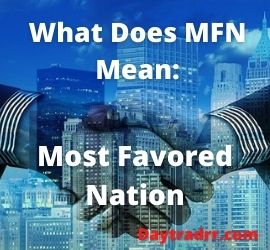What are TruPS – Trust Preferred Securities?
 TruPS are trust-preferred securities issued by bank holding companies (BHC). They have some characteristics of both preferred stock equity and subordinated debt.
TruPS are trust-preferred securities issued by bank holding companies (BHC). They have some characteristics of both preferred stock equity and subordinated debt.
Trust preferred securities (TruPS) are hybrid securities. They are issued by banks and bank holding companies (BHCs) beginning in 1996. The funds held in trust initially were included in regulatory tier 1 capital. Also, the dividend payments were tax deductible for the issuer. However, these two advantages to the issuer have been modified through subsequent regulation over the years.
Initially, the bank would open a trust fund with debt. Then, the bank would parcel out shares of the trust and sell them to investors in the form of preferred stock. The resulting stock is called trust preferred security or TruPS. When buying a trust preferred security, the investor is buying a portion of the trust and its underlying holdings. Owning TRUPs is not a piece of ownership in the bank itself.
Following the 2008-09 financial crisis, TruPS came under heightened regulatory scrutiny. The majority of these issues were phased out by the end of 2015. This came as a result of the Dodd-Frank regulations and the Volcker Rule.
TruPS Background
TruPS are long-term debt securities issued by banks or bank holding companies with less than $50 billion in assets. They are essentially debt-funded trust shares that generate cash flow in the same manner as preferred stock. Prior to the financial crisis, banks routinely issued TruPS in lieu of subordinated debt. This is because they counted as Tier I capital and the interest payments to investors were tax-deductible to the bank trust. The TruPS collateralized debt obligation (CDO) market arose in the mid-1990s. TruPS were intended to help these small banks improve their issuance pricing and volume. It performed effectively and grew to over $60 billion before the financial crisis of 2008. At that point, prices plummeted and new issuing almost ended.
The trust preferred security has characteristics of both stock and debt. While the trust is funded with debt, the shares issued are considered to be preferred stock and even pay dividends like preferred stock. However, since the trust holds the bank’s debt as the funding vehicle, the payments the investors receive are actually interest payments and are taxed as such by the IRS. (Source: investopedia.com)
TruPS – How They Work
In a typical trust-preferred structure, a parent Bank Holding Company creates a trust subsidiary. It then issues TruPS, which are then sold to investors. The trust uses the proceeds from the sale to purchase long-term debentures. These are debt instruments that aren’t secured by physical assets or collateral by the Parent Holding Company.
- Attractive interest rates – The trust preferred security usually offers a higher periodic payment than a share of preferred stock
- Long maturity life – and can have a maturity of up to 30 years due to the long maturity timeline of the debt used to fund the trust.
- Flexible payment schedule for issuer – The payments to stockholders can be on a fixed schedule or variable. In addition, some of the provisions in trust preferred securities can allow for the deferral of interest payments for up to five years.
- Early redemption clause – The TruPS matures at face value at the end of the term, but there is the potential for early redemption if the issuer chooses.
Banks would establish trust preferred securities because of their favorable accounting treatment and flexibility. According to GAAP rules, these securities are taxed by the Internal Revenue Service as debt obligations. However, they appear as equity in a company’s accounting statements. The trust receives tax-deductible interest payments from the issuing bank, which are then dispersed to the trust’s stockholders.
TruPS became extremely popular among banking organizations because their dividends are tax-deductible and their issuance does not dilute the equity of the BHC. Roughly half the 308 banking companies with higher dependence on TruPS were smaller banking companies with total assets of $1 billion or less. The Federal Reserve’s decision to allow TruPS to satisfy part of BHCs’ tier 1 capital requirement was important to insured banks as well. (Source: fdic.gov)
TruPS – Advantages and Disadvantages
Advantages
- Favorable tax treatment for issuers – Trust preferred securities are used by bank holding companies because they provide favorable tax, accounting, and regulatory capital treatments. Subordinated debt securities are taxed similarly to debt obligations by the IRS, therefore interest payments are deductible. Dividends on preferred stock, on the other hand, are paid out of after-tax earnings. As a result, the firm’s funding expenses may be significantly decreased.
- Funds treated as capital – If issued by a bank holding company, the funds are treated as capital rather than liabilities under banking legislation. Further, funds may be designated as tier 1 capital (the highest quality capital) if certain criteria are met. A financial institution’s liabilities such as deposits are limited to a multiple of its capital. As a result, this regulatory treatment is highly advantageous. This is why bank holding corporations prefer the trust preferred method as a way to raise capital.
- Tier 1 capital qualification – To qualify as Tier 1 capital, such securities must include a five-year consecutive deferral term on payments to preferred shareholders. Furthermore, the intercompany loan must be subordinated to all subordinated obligations and have the shortest possible duration. These instruments, along with other cumulative preferred stock that a bank holding company may include in Tier 1 capital, may account for up to 25% of the total amount of core capital elements, including cumulative perpetual preferred stock and trust preferred stock. Non-financial enterprises are more inclined to adopt simpler structures, such as issuing junior subordinated debt to the general public. (Source: en.wikipedia.org)
Disadvantages
The principal disadvantage of trust preferred securities is cost. Trust preferred securities are subordinated to all of the issuer’s other debt. Typically, they have features like early redemption and optional deferral of interest payments. To attract investors and properly compensate them, TRUPS must provide high-interest rates. These rates will be much higher than ordinary senior debt or subordinated debt. Offering costs are high as well. Investment banks will take a large underwriting fee to sell the securities to the public. Legal and accounting fees will also be high.
Finally, the costs are among the disadvantages for companies issuing trust preferred securities because the trusts sometimes have features like deferral of interest payments and early redemption of shares. These nuances make them less attractive to investors and, therefore, the rates on trust preferred securities are typically higher than those offered on other types of debt, simply investors demand a greater rate of return. The costs of investment banking fees for underwriting the securities can be hefty as well. (Source: investopedia.com)
TruPS – An Uncertain Future
The Dodd-Frank financial reform legislation was enacted in 2010. Among other things, it contains a provision requiring the phase-out of Tier 1 capital status of trust preferred securities issued by large institutions. Specifically, banks with more than $15 billion in assets by 2013.
Note: Tier 1 capital treatment means that banks can use the money invested in their trust preferred securities to calculate their Tier 1 capital ratio. This is the amount of money banks have on hand to cover bad loan losses.
Excluding or phasing out trust preferred securities from the Tier 1 capital ratio raises financing requirements for banks. Additionally, in some situations, it lowers the number of incentives for banks to issue trust preferred securities. Further, the so-called Collins Amendment was proposed in the United States Senate to completely abolish trust preferred securities as Tier 1 regulatory capital.
Up Next: What Does MFN Mean?
 What does MFN mean? It is an acronym for Most Favored Nation status. It represents a high level of treatment from one state to another in international trade and finance. The term comes from the field of international trade.
What does MFN mean? It is an acronym for Most Favored Nation status. It represents a high level of treatment from one state to another in international trade and finance. The term comes from the field of international trade.
Treaties and trade agreements often include provisions that require a nation to receive a minimum level of treatment.
MFN status does not give preferential treatment to a single trading partner. Rather, Most Favored Nation status pledges minimum treatment equal to any other trading partner. This is in terms of tariffs, quotas, and trade barriers, among others.




